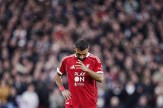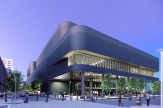Northeastern graduate Kelley Becherer is a repeat Paralympian — most recently, as a physical therapist
An elite college swimmer, Becherer completed a PT degree while winning paralympic gold. In Paris, she worked in the Olympic Village helping athletes from fencers to wheelchair basketball players perform at their best.
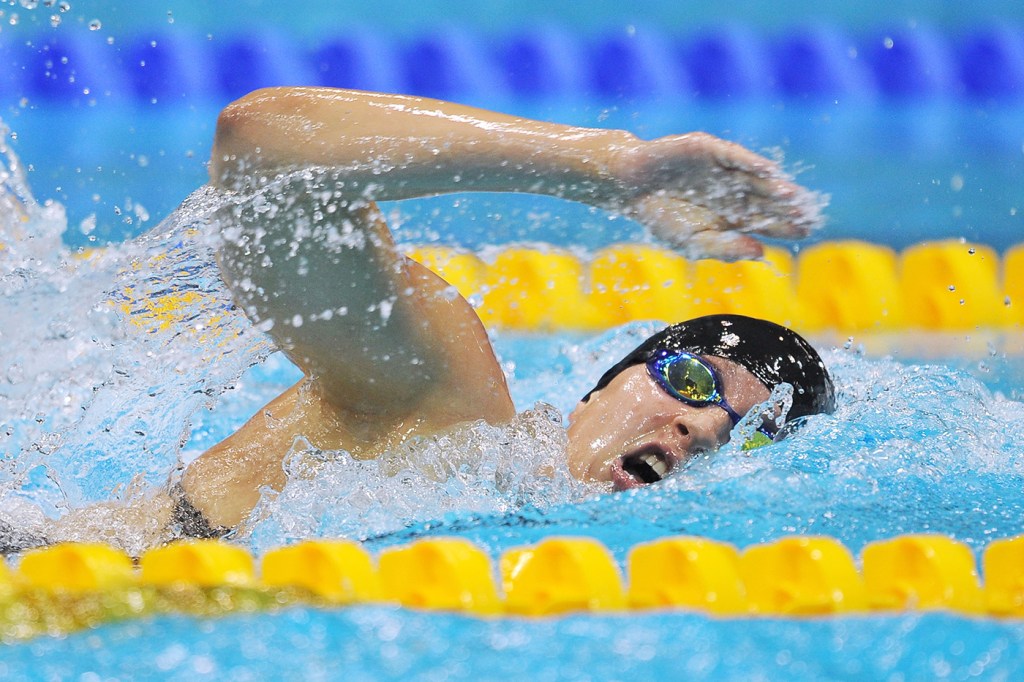
This past summer in Paris was a busy one for Kelley Becherer. In late August, she lived in Team USA’s dorms in the Olympic Village during the Paralympics, meeting elite para athletes from every sport under the sun, cheering them on and doing her part to help them perform at their best.
The last night of the Games, she was ecstatic to watch the men’s wheelchair basketball team clinch gold over Great Britain.
“We’d been hanging out with those guys for two plus weeks,” the 2015 Northeastern graduate says. “Seeing that happen was such a thrilling moment in the Games.”
Becherer is no stranger to the Paralympics. An elite swimmer with a severe visual impairment, she made her debut as a young teenager at the 2004 Paralympics in Athens, ultimately competing in three Games as a freestyler and winning gold medals in Beijing and London.
But in Paris, she was once again a rookie — making her first trip as an orthopedic physical therapist for Team USA. Working in the sports medicine tent in the Olympic Village, Becherer iced down, taped up, and stretched out athletes with a wide range of physical abilities, competing in every sport under the sun.
At first, that vast variety was intimidating. Despite being a para athlete herself, it wasn’t something with which Becherer had much experience as a practitioner. But she caught on quickly.
“You’re seeing all these different body types and impairments,” she says, “but these are all people who have made it to an elite level and know what they need. Even though someone might be, like, a bilateral amputee, they still need the same type of hip stretching or shoulder recovery that any other athlete needs.”
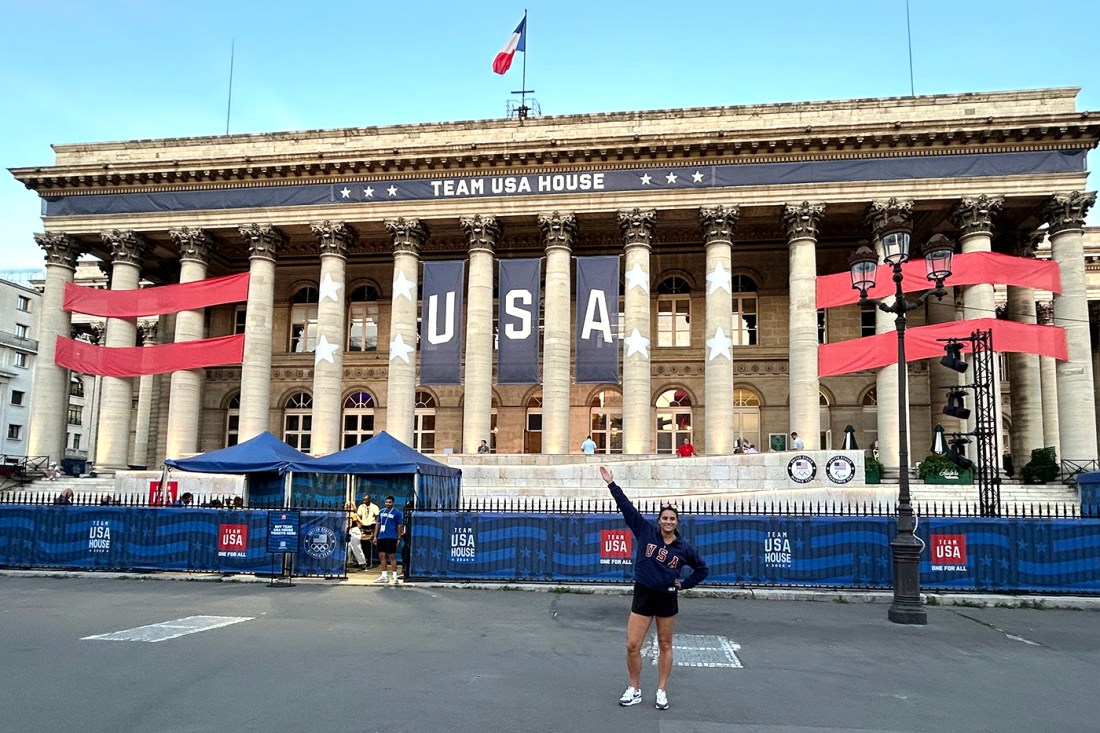
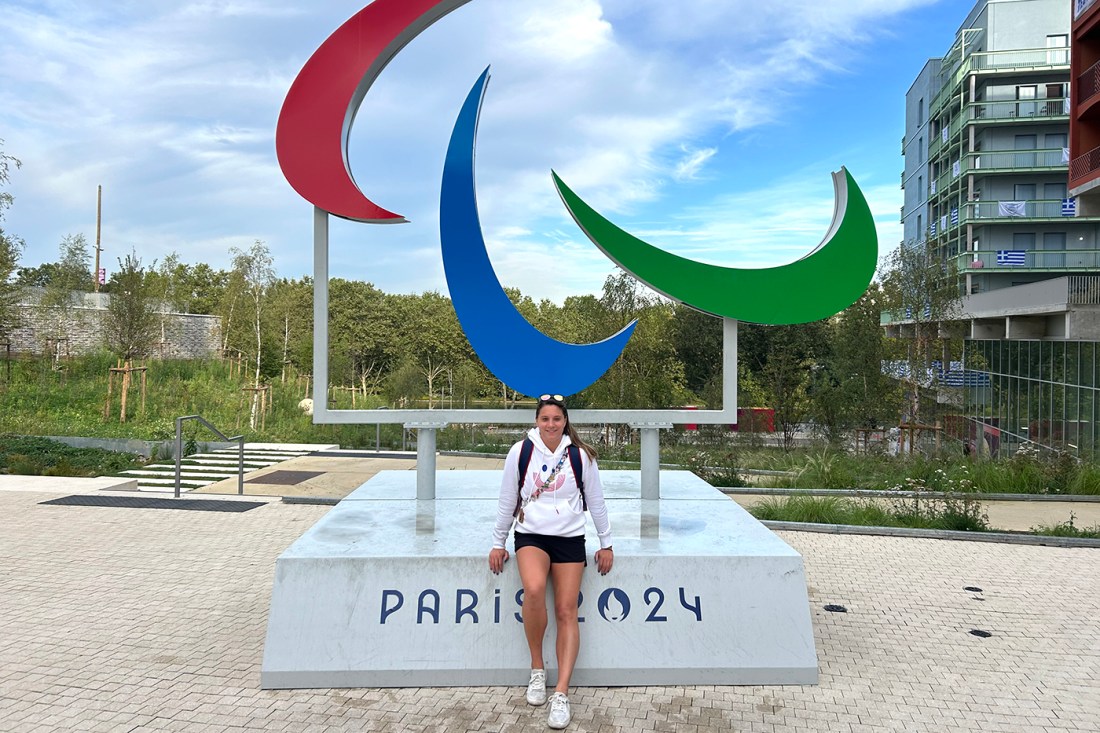
Becherer’s Paris experience marked the culmination of a two-pronged journey she started at Northeastern. She arrived on the Boston campus in 2009, set on simultaneously becoming a top NCAA swimmer and completing Northeastern’s rigorous, (then) six-year physical therapy program — all while continuing her run as a decorated Paralympian.
“She came in and explained that she was interested in being on a competitive Division I team, but also that she had a disability and all that goes along with the Paralympic Nationals,” remembers Roy Coates, the university’s longtime swim coach. “She wanted to know if it was possible to do both at Northeastern. And it certainly was. There was nothing Kelley couldn’t do.”
‘I could do it without feeling limited’
Becherer was born with bilateral coloboma and microphthalmia, congenital conditions that affect vision. “Normal,” unimpaired eyesight is 20/20; Becherer’s is around 20/500. She can’t see things far away or peripherally, she requires enlarged printouts and screen displays for class materials, and she doesn’t drive.
But in the pool, none of that comes up. Raised in an athletic family in Sheboygan, Wisconsin, Becherer tried her hand at lots of different sports as a kid: soccer, track and field, basketball. “But I just loved being in the water,” she says. “It was something I could do without feeling limited or having any accommodations. I think that’s why I was pulled towards it a little bit more.”
As a pre-teen, Becherer started participating in sports camps for the visually impaired around Wisconsin, and a coach soon asked if she was interested in Paralympic swimming. She made her Paralympic debut at age 14 and was a medalist in Beijing before she finished high school.
Being in Paralympic circles sparked her interest in sports rehab, but picking the right college was complex. In addition to picking the right degree program, she wanted to swim at the Division I level and live in a walkable city with public transit, where she wouldn’t feel limited by the fact that she doesn’t drive.
“She actually told me that one of the reasons she came to Northeastern was the bricks,” Coates says. “She couldn’t see across a big green, but she knew the brick walkways and what buildings were next to one another. It really helped her get around.”
As far as pool accommodations went, she didn’t need much — the athletic department bought a clock to put in her practice lane. She thrived on the team, competing in freestyle and a little bit of backstroke.
“I remember wondering if we could put her on relays,” Coates says. “Obviously you need to see the swimmer coming in and you need to time it correctly. The funniest thing about Kelly was she was probably the best one on the team for relay pickups. She had better timing than most everybody else.”
As a senior, Becherer made the finals in 100 meter freestyle at the NCAA Tournament — a highlight of her college career. “I had one of the best races of my life,” she says. “It showed me that yes, I was a good paralympic swimmer. But I was also a good collegiate swimmer.”
In training
She continued to be a good paralympic swimmer, winning a pair of gold medals at the 2012 London Games and breaking her own American record in the 50-meter freestyle. The NCAA swimming and diving season typically runs from September to March; paralympic competitions run mainly during the summer, allowing Becherer to compete in both without much interruption.
At the same time, she was a student in the physical therapy program, which was then a six-year combined undergraduate and graduate program resulting in a professional doctorate. Fitting the demands of the curriculum — including two co-ops — around an elite swimming career proved more challenging. But the university worked with her: To satisfy the PT program’s requirement for one co-op in the spring (when swimming competitions heat up) Becherer worked in Northestern’s athletic training room, primarily with the men’s hockey team.
“That was one of the best things that could have happened,” she says. “It let me see how to write a strength and conditioning program, how to run all the tests. I learned a lot more taping skills, and I did sideline care where I sat on the side of the ring in case someone got injured. I think that exposure [taught me] that this was 100% the physical therapy field that I wanted to go into.”
Featured Posts
After graduating in 2015, Becherer moved out to practice in San Diego with Lauren Tarsi, a fellow PT student. “When we worked together patients loved her,” Tarsi says “She’s super personable and super smart about a wide range of orthopedic injuries.”
Now board certified as an orthopedic specialist, Becherer practices at UC San Diego Health’s outpatient sports clinic. Along with D1 athletes from UCSD and surrounding schools, her clientele “can be anyone from a 15-year-old athlete to an 80-year-old with balance issues,” she says.
Back to the Games
After nearly a decade in practice, Becherer was seasoned enough to put her hat in the ring for the Paralympics. She applied and was accepted for the volunteer therapist rotation for the games, then worked at a Paralympic training center for two weeks in Colorado Springs.
“I was assigned wrestling,” she says. “So I sat on the sidelines during matches, worked on injuries and stretched [people] out afterwards.”
About six months before Paris, she was invited to work for Team USA in the Village and jumped at the chance.
“I was a little nervous; obviously I have been to games as an athlete, but this was completely new to me,” she says. “In my regular job, I don’t really treat that. I see some patients with amputees, but that’s probably the closest I get. But I also am super lucky that I have been exposed to that world since I was a child.”
She lived and worked in the athlete’s village, logging 11-hour shifts as one of two PTs working alongside trainers, doctors, massage therapists and chiropractors. Along the way, she learned the particular physical needs of a huge diversity of top-level athletes.
For instance, “I learned a lot about fencing,” she says. “A lot of [fencers] had neck pain because they’re always looking one way and have their arm up. It was awesome to learn about it, and those athletes are super helpful and just able to kind of open up and share what they do every day and how they train.”
She adds that the added physical strain of the games can be exacerbated for competitors with impairments or limited mobility. “We put them on a plane for 10 hours, then we put them in beds that they’re not used to and even, like clothing and shoes that might not be what they’re used to. It’s a lot of little things you don’t think about, and our job is ‘how do we get you back to your baseline so you can compete at your best?’”
Helping give athletes that extra bit they might have needed — then watching them succeed — made the long hours barely noticeable. “I wasn’t even tired until I got home,” she says. “It’s truly that Olympic spirit. Everyone’s in such a good mood. The athletes are all excited to be there and you’re excited to be there.”
She’s also excited by the fact that the 2028 Paralympics will be just up the road from her, in Los Angeles.
“I would love to help out again.”







